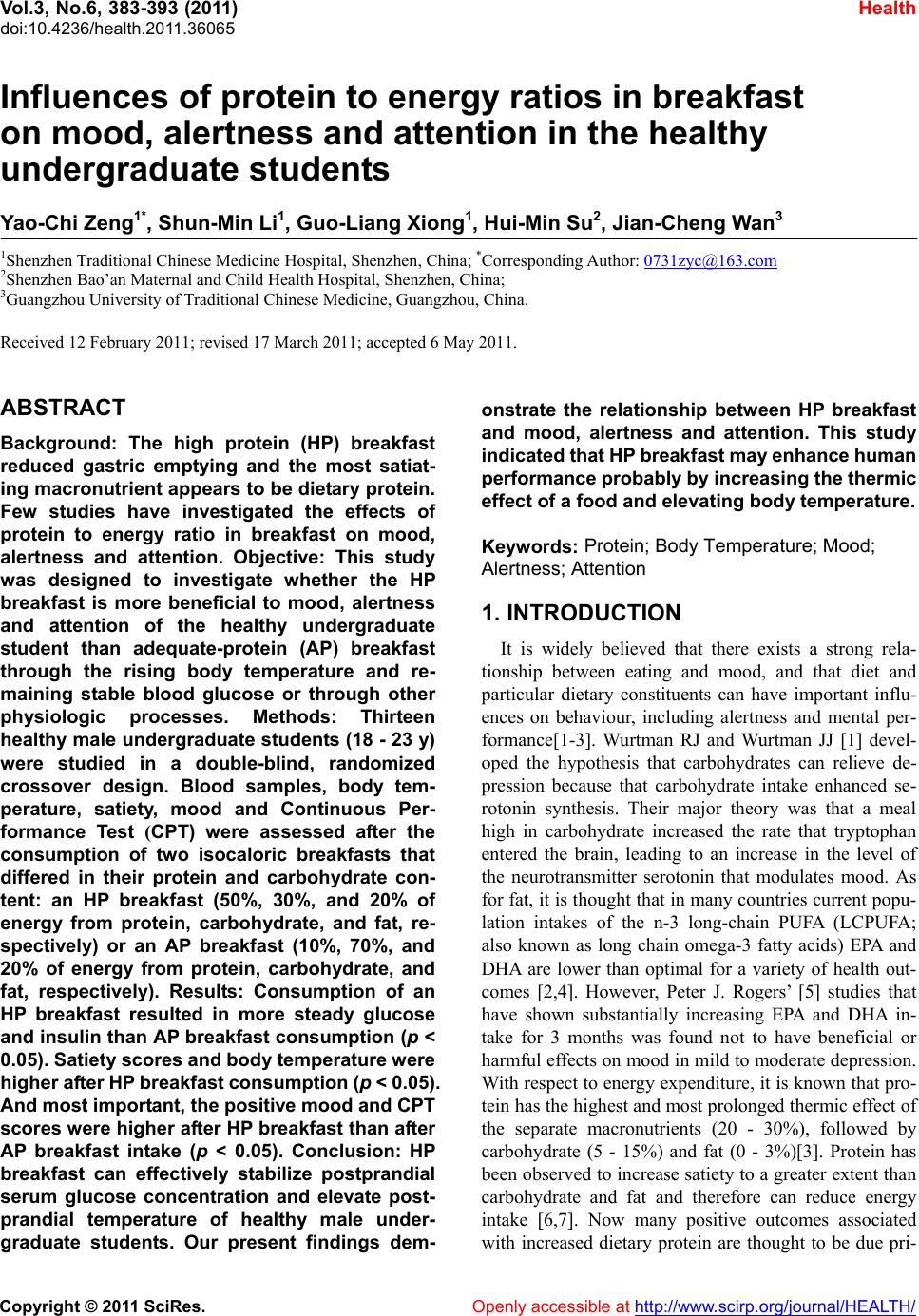 Vol.3, No.6, 383-393 (2011) doi:10.4236/health.2011.36065 C opyright © 2011 SciRes. Openly accessible at http://www.scirp.org/journal/HEALTH/ Health Influences of protein to energy ratios in breakfast on mood, alertness and attention in the healthy undergraduate students Yao-Chi Zeng1*, Shun-Min Li1, Guo-Liang Xiong1, Hui-Min Su2, Jian-Cheng Wan3 1Shenzhen Traditional Chinese Medicine Hospital, Shenzhen, China; *Corresponding Author: 0731zyc@163.com 2Shenzhen Bao’an Maternal and Child Health Hospital, Shenzhen, China; 3Guangzhou University of Traditional Chinese Medicine, Guangzhou, China. Received 12 February 2011; revised 17 March 2011; accepted 6 May 2011. ABSTRACT Background: The high protein (HP) breakfast reduced gastric emptying and the most satiat- ing macronutrient appears to be dietary protein. Few studies have investigated the effects of protein to energy ratio in breakfast on mood, alertness and attention. Objective: This study was designed to investigate whether the HP breakfast is more beneficial to mood, alertness and attention of the healthy undergraduate student than adequate-protein (AP) breakfast through the rising body temperature and re- maining stable blood glucose or through other physiologic processes. Methods: Thirteen healthy male undergraduate students (18 - 23 y) were studied in a double-blind, randomized crossover design. Blood samples, body tem- perature, satiety, mood and Continuous Per- formance Test (CPT) were assessed after the consumption of two isocaloric breakfasts that differed in their protein and carbohydrate con- tent: an HP breakfast (50%, 30%, and 20% of energy from protein, carbohydrate, and fat, re- spectively) or an AP breakfast (10%, 70%, and 20% of energy from protein, carbohydrate, and fat, respectively). Results: Consumption of an HP breakfast resulted in more steady glucose and insulin than AP breakfast consumption (p < 0.05). Satiety sc ores and body tem perat ure were higher af ter HP breakfas t consumpt ion (p < 0.05). And most import ant, the positiv e mood and CPT scores w ere higher after HP breakfast than after AP breakfast intake (p < 0.05). Conclusion: HP breakfast can effectively stabilize postprandial serum glucose concentration and elevate post- prandial temperature of healthy male under- graduate students. Our present findings dem- onstrate the relationship between HP breakfast and mood, alertness and attention. This study indicated th at HP brea kfast may enhance hum an performance probably by increasing the thermic effect of a food and elevating body temperature. Keywords: Protein; Body Temperature; Mood; Alertness; Attention 1. INTRODUCTION It is widely believed that there exists a strong rela- tionship between eating and mood, and that diet and particular dietary constituents can have important influ- ences on behaviour, including alertness and mental per- formance[1-3]. Wurtman RJ and Wurtman JJ [1] devel- oped the hypothesis that carbohydrates can relieve de- pression because that carbohydrate intake enhanced se- rotonin synthesis. Their major theory was that a meal high in carbohydrate increased the rate that tryptophan entered the brain, leading to an increase in the level of the neurotransmitter serotonin that modulates mood. As for fat, it is thought that in many countries current popu- lation intakes of the n-3 long-chain PUFA (LCPUFA; also known as long chain omega-3 fatty acids) EPA and DHA are lower than optimal for a variety of health out- comes [2,4]. However, Peter J. Rogers’ [5] studies that have shown substantially increasing EPA and DHA in- take for 3 months was found not to have beneficial or harmful effects on mood in mild to moderate depression. With respect to energy expenditure, it is known that pro- tein has the highest and most prolonged thermic effect of the separate macronutrients (20 - 30%), followed by carbohydrate (5 - 15%) and fat (0 - 3%)[3]. Protein has been observed to increase satiety to a greater extent than carbohydrate and fat and therefore can reduce energy intake [6,7]. Now many positive outcomes associated with increased dietary protein are thought to be due pri- 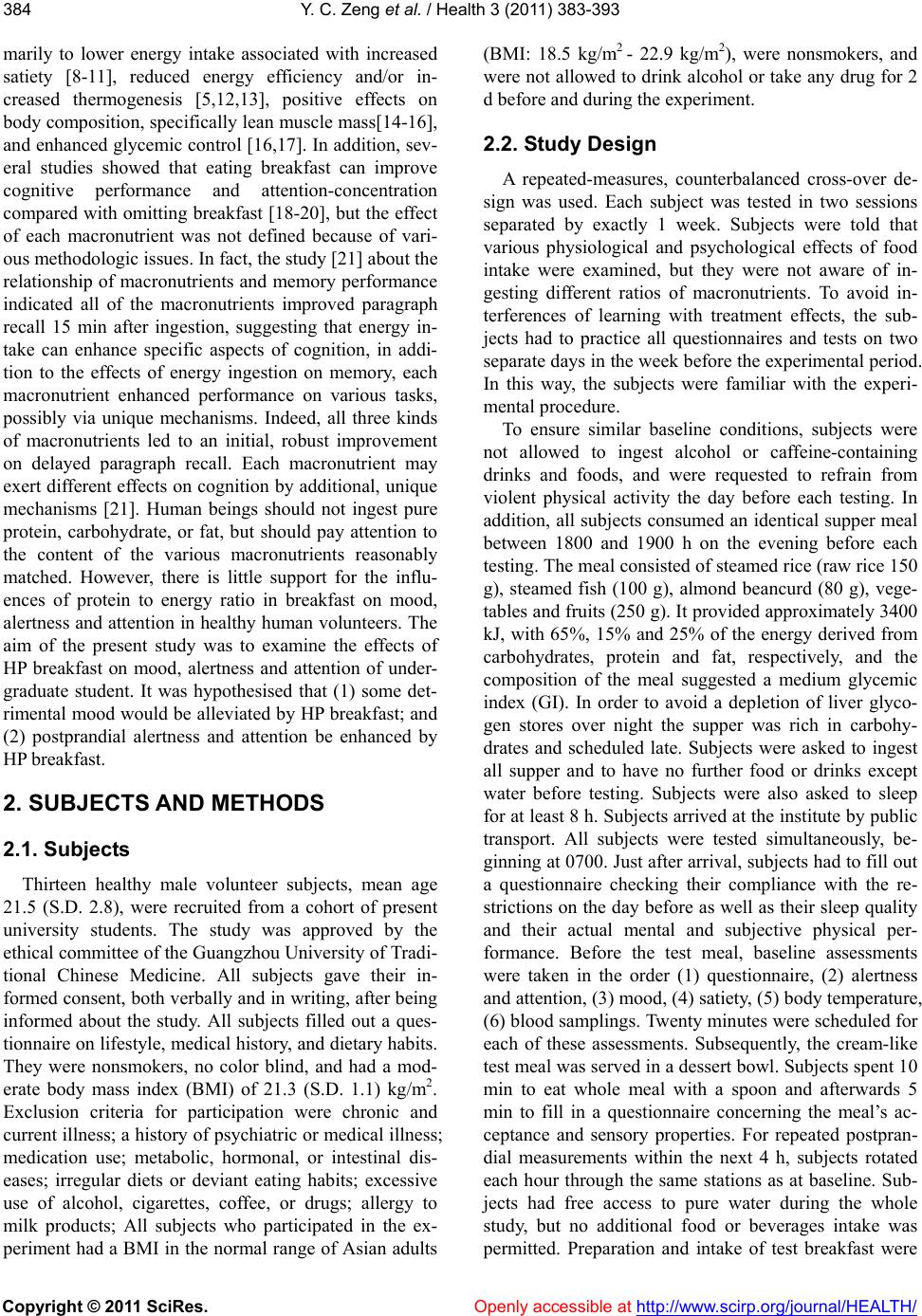 Y. C. Zeng et al. / Health 3 (2011) 383-393 Copyright © 2011 SciRes. Openly accessible at http://www.scirp.org/journal/HEALTH/ 384 marily to lower energy intake associated with increased satiety [8-11], reduced energy efficiency and/or in- creased thermogenesis [5,12,13], positive effects on body composition, specifically lean muscle mass[14-16], and enhanced glycemic control [16,17]. In addition, sev- eral studies showed that eating breakfast can improve cognitive performance and attention-concentration compared with omitting breakfast [18-20], but the effect of each macronutrient was not defined because of vari- ous methodologic issues. In fact, the study [21] about the relationship of macronutrients and memory performance indicated all of the macronutrients improved paragraph recall 15 min after ingestion, suggesting that energy in- take can enhance specific aspects of cognition, in addi- tion to the effects of energy ingestion on memory, each macronutrient enhanced performance on various tasks, possibly via unique mechanisms. Indeed, all three kinds of macronutrients led to an initial, robust improvement on delayed paragraph recall. Each macronutrient may exert different effects on cognition by additional, unique mechanisms [21]. Human beings should not ingest pure protein, carbohydrate, or fat, but should pay attention to the content of the various macronutrients reasonably matched. However, there is little support for the influ- ences of protein to energy ratio in breakfast on mood, alertness and attention in healthy human volunteers. The aim of the present study was to examine the effects of HP breakfast on mood, alertness and attention of under- graduate student. It was hypothesised that (1) some det- rimental mood would be alleviated by HP breakfast; and (2) postprandial alertness and attention be enhanced by HP breakfast. 2. SUBJECTS AND METHODS 2.1. Subjects Thirteen healthy male volunteer subjects, mean age 21.5 (S.D. 2.8), were recruited from a cohort of present university students. The study was approved by the ethical committee of the Guangzhou University of Tradi- tional Chinese Medicine. All subjects gave their in- formed consent, both verbally and in writing, after being informed about the study. All subjects filled out a ques- tionnaire on lifestyle, medical history, and dietary habits. They were nonsmokers, no color blind, and had a mod- erate body mass index (BMI) of 21.3 (S.D. 1.1) kg/m2. Exclusion criteria for participation were chronic and current illness; a history of psychiatric or medical illness; medication use; metabolic, hormonal, or intestinal dis- eases; irregular diets or deviant eating habits; excessive use of alcohol, cigarettes, coffee, or drugs; allergy to milk products; All subjects who participated in the ex- periment had a BMI in the normal range of Asian adults (BMI: 18.5 kg/m2 - 22.9 kg/m2), were nonsmokers, and were not allowed to drink alcohol or take any drug for 2 d before and during the experiment. 2.2. Stud y Design A repeated-measures, counterbalanced cross-over de- sign was used. Each subject was tested in two sessions separated by exactly 1 week. Subjects were told that various physiological and psychological effects of food intake were examined, but they were not aware of in- gesting different ratios of macronutrients. To avoid in- terferences of learning with treatment effects, the sub- jects had to practice all questionnaires and tests on two separate days in the week before the experimental period. In this way, the subjects were familiar with the experi- mental procedure. To ensure similar baseline conditions, subjects were not allowed to ingest alcohol or caffeine-containing drinks and foods, and were requested to refrain from violent physical activity the day before each testing. In addition, all subjects consumed an identical supper meal between 1800 and 1900 h on the evening before each testing. The meal consisted of steamed rice (raw rice 150 g), steamed fish (100 g), almond beancurd (80 g), vege- tables and fruits (250 g). It provided approximately 3400 kJ, with 65%, 15% and 25% of the energy derived from carbohydrates, protein and fat, respectively, and the composition of the meal suggested a medium glycemic index (GI). In order to avoid a depletion of liver glyco- gen stores over night the supper was rich in carbohy- drates and scheduled late. Subjects were asked to ingest all supper and to have no further food or drinks except water before testing. Subjects were also asked to sleep for at least 8 h. Subjects arrived at the institute by public transport. All subjects were tested simultaneously, be- ginning at 0700. Just after arrival, subjects had to fill out a questionnaire checking their compliance with the re- strictions on the day before as well as their sleep quality and their actual mental and subjective physical per- formance. Before the test meal, baseline assessments were taken in the order (1) questionnaire, (2) alertness and attention, (3) mood, (4) satiety, (5) body temperature, (6) blood samplings. Twenty minutes were scheduled for each of these assessments. Subsequently, the cream-like test meal was served in a dessert bowl. Subjects spent 10 min to eat whole meal with a spoon and afterwards 5 min to fill in a questionnaire concerning the meal’s ac- ceptance and sensory properties. For repeated postpran- dial measurements within the next 4 h, subjects rotated each hour through the same stations as at baseline. Sub- jects had free access to pure water during the whole study, but no additional food or beverages intake was permitted. Preparation and intake of test breakfast were 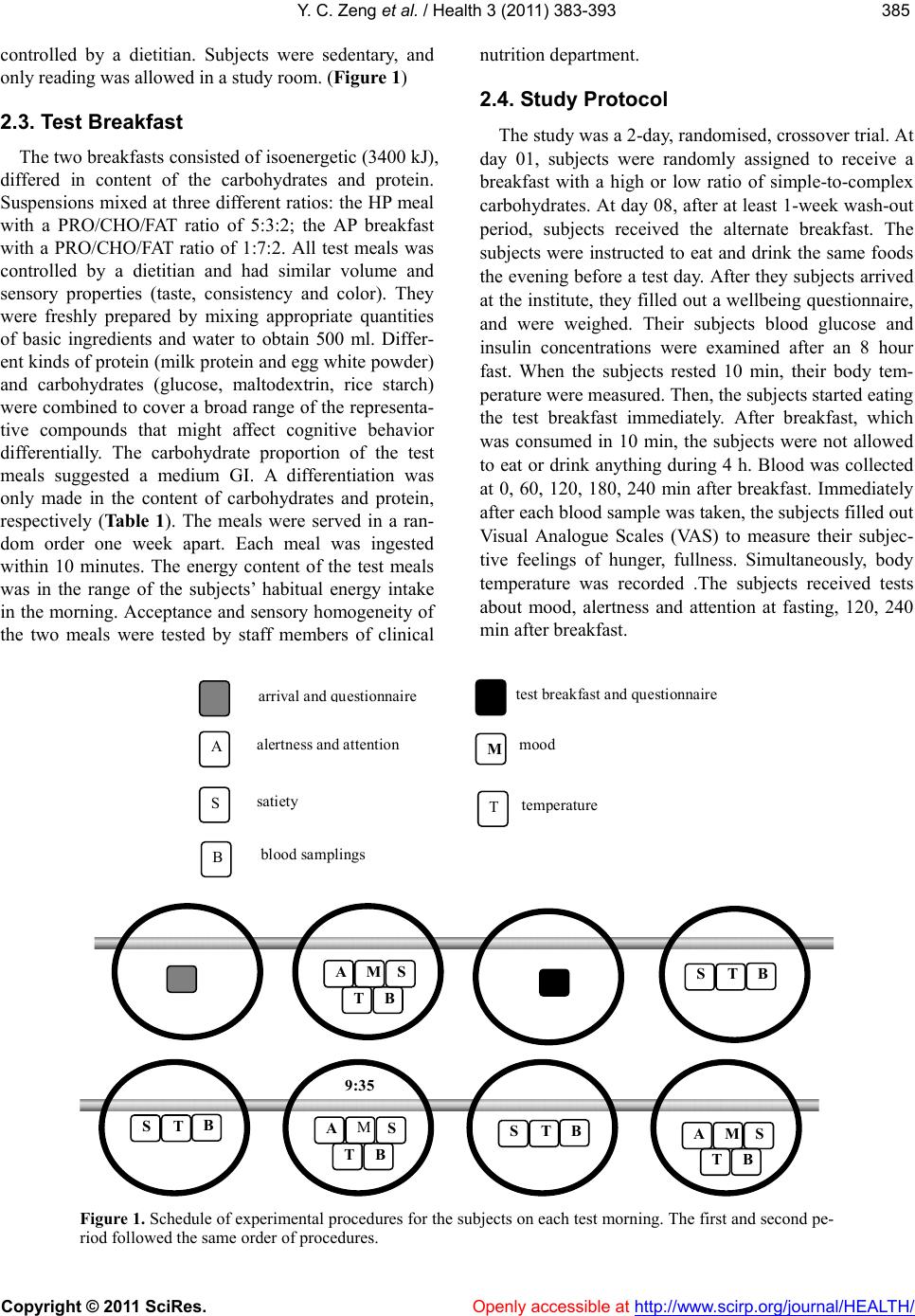 Y. C. Zeng et al. / Health 3 (2011) 383-393 Copyright © 2011 SciRes. http://www.scirp.org/journal/HEALTH/ 385385 controlled by a dietitian. Subjects were sedentary, and only reading was allowed in a study room. (Figure 1) Openly accessible at 2.3. Test Breakfast The two breakfasts consisted of isoenergetic (3400 kJ), differed in content of the carbohydrates and protein. Suspensions mixed at three different ratios: the HP meal with a PRO/CHO/FAT ratio of 5:3:2; the AP breakfast with a PRO/CHO/FAT ratio of 1:7:2. All test meals was controlled by a dietitian and had similar volume and sensory properties (taste, consistency and color). They were freshly prepared by mixing appropriate quantities of basic ingredients and water to obtain 500 ml. Differ- ent kinds of protein (milk protein and egg white powder) and carbohydrates (glucose, maltodextrin, rice starch) were combined to cover a broad range of the representa- tive compounds that might affect cognitive behavior differentially. The carbohydrate proportion of the test meals suggested a medium GI. A differentiation was only made in the content of carbohydrates and protein, respectively (Ta b l e 1 ). The meals were served in a ran- dom order one week apart. Each meal was ingested within 10 minutes. The energy content of the test meals was in the range of the subjects’ habitual energy intake in the morning. Acceptance and sensory homogeneity of the two meals were tested by staff members of clinical nutrition department. 2.4. Study Protocol The study was a 2-day, randomised, crossover trial. At day 01, subjects were randomly assigned to receive a breakfast with a high or low ratio of simple-to-complex carbohydrates. At day 08, after at least 1-week wash-out period, subjects received the alternate breakfast. The subjects were instructed to eat and drink the same foods the evening before a test day. After they subjects arrived at the institute, they filled out a wellbeing questionnaire, and were weighed. Their subjects blood glucose and insulin concentrations were examined after an 8 hour fast. When the subjects rested 10 min, their body tem- perature were measured. Then, the subjects started eating the test breakfast immediately. After breakfast, which was consumed in 10 min, the subjects were not allowed to eat or drink anything during 4 h. Blood was collected at 0, 60, 120, 180, 240 min after breakfast. Immediately after each blood sample was taken, the subjects filled out Visual Analogue Scales (VAS) to measure their subjec- tive feelings of hunger, fullness. Simultaneously, body temperature was recorded .The subjects received tests about mood, alertness and attention at fasting, 120, 240 min after breakfast. A M S T B S T B S T B ST B 9:35 A MS T BA M S T B M S B T arrival and uestionnaire alertness and attentionmoo satiet lood sam lin s tem erature test breakfast and questionnaire Figure 1. Schedule of experimental procedures for the subjects on each test morning. The first and second pe- riod followed the same order of procedures. 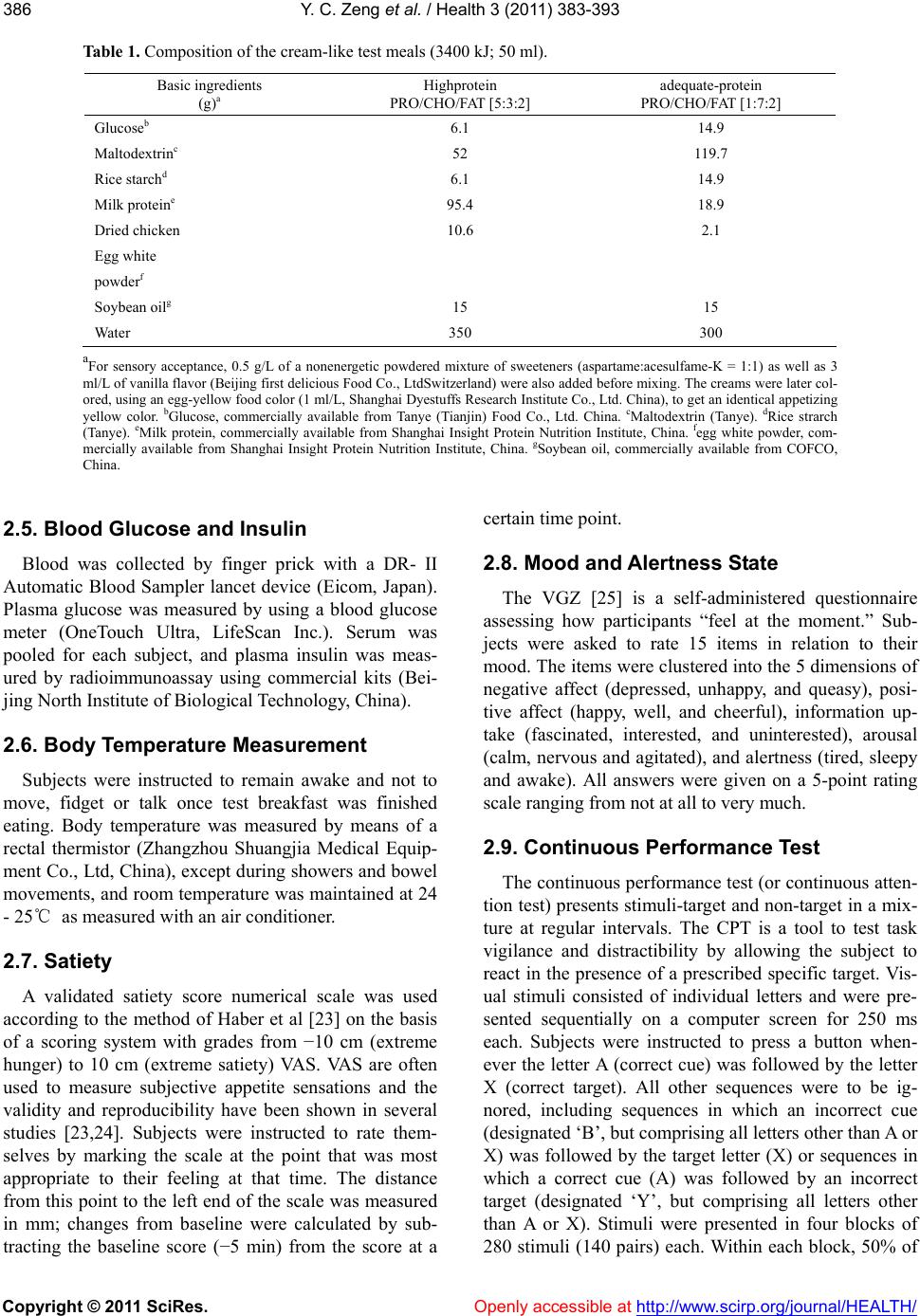 Y. C. Zeng et al. / Health 3 (20 11) 383-393 Copyright © 2011 SciRes. Openly accessible at http://www.scirp.org/journal/HEALTH/ 386 Table 1. Composition of the cream-like test meals (3400 kJ; 50 ml). Basic ingredients (g)a Highprotein PRO/CHO/FAT [5:3:2] adequate-protein PRO/CHO/FAT [1:7:2] Glucoseb 6.1 14.9 Maltodextrinc 52 119.7 Rice starchd 6.1 14.9 Milk proteine 95.4 18.9 Dried chicken 10.6 2.1 Egg white powderf Soybean oilg 15 15 Water 350 300 aFor sensory acceptance, 0.5 g/L of a nonenergetic powdered mixture of sweeteners (aspartame:acesulfame-K = 1:1) as well as 3 ml/L of vanilla flavor (Beijing first delicious Food Co., LtdSwitzerland) were also added before mixing. The creams were later col- ored, using an egg-yellow food color (1 ml/L, Shanghai Dyestuffs Research Institute Co., Ltd. China), to get an identical appetizing yellow color. bGlucose, commercially available from Tanye (Tianjin) Food Co., Ltd. China. cMaltodextrin (Tanye). dRice strarch (Tanye). eMilk protein, commercially available from Shanghai Insight Protein Nutrition Institute, China. fegg white powder, com- mercially available from Shanghai Insight Protein Nutrition Institute, China. gSoybean oil, commercially available from COFCO, China. 2.5. Blood Glucose and Insulin Blood was collected by finger prick with a DR- II Automatic Blood Sampler lancet device (Eicom, Japan). Plasma glucose was measured by using a blood glucose meter (OneTouch Ultra, LifeScan Inc.). Serum was pooled for each subject, and plasma insulin was meas- ured by radioimmunoassay using commercial kits (Bei- jing North Institute of Biological Technology, China). 2.6. Body Temperature Measurement Subjects were instructed to remain awake and not to move, fidget or talk once test breakfast was finished eating. Body temperature was measured by means of a rectal thermistor (Zhangzhou Shuangjia Medical Equip- ment Co., Ltd, China), except during showers and bowel movements, and room temperature was maintained at 24 - 25℃ as measured with an air conditioner. 2.7. Satiety A validated satiety score numerical scale was used according to the method of Haber et al [23] on the basis of a scoring system with grades from −10 cm (extreme hunger) to 10 cm (extreme satiety) VAS. VAS are often used to measure subjective appetite sensations and the validity and reproducibility have been shown in several studies [23,24]. Subjects were instructed to rate them- selves by marking the scale at the point that was most appropriate to their feeling at that time. The distance from this point to the left end of the scale was measured in mm; changes from baseline were calculated by sub- tracting the baseline score (−5 min) from the score at a certain time point. 2.8. Mood and Alertness State The VGZ [25] is a self-administered questionnaire assessing how participants “feel at the moment.” Sub- jects were asked to rate 15 items in relation to their mood. The items were clustered into the 5 dimensions of negative affect (depressed, unhappy, and queasy), posi- tive affect (happy, well, and cheerful), information up- take (fascinated, interested, and uninterested), arousal (calm, nervous and agitated), and alertness (tired, sleepy and awake). All answers were given on a 5-point rating scale ranging from not at all to very much. 2.9. Continuous Performance Test The continuous performance test (or continuous atten- tion test) presents stimuli-target and non-target in a mix- ture at regular intervals. The CPT is a tool to test task vigilance and distractibility by allowing the subject to react in the presence of a prescribed specific target. Vis- ual stimuli consisted of individual letters and were pre- sented sequentially on a computer screen for 250 ms each. Subjects were instructed to press a button when- ever the letter A (correct cue) was followed by the letter X (correct target). All other sequences were to be ig- nored, including sequences in which an incorrect cue (designated ‘B’, but comprising all letters other than A or X) was followed by the target letter (X) or sequences in which a correct cue (A) was followed by an incorrect target (designated ‘Y’, but comprising all letters other than A or X). Stimuli were presented in four blocks of 280 stimuli (140 pairs) each. Within each block, 50% of  Y. C. Zeng et al. / Health 3 (20 11) 383-393 Copyright © 2011 SciRes. Openly accessible at http://www.scirp.org/journal/HEALTH/ 387387 the cue-target sequences were presented with short (0.8 s) interstimulus interval (ISI) and 50% with long ISI (4 s). Short and long ISIs were pseudorandomly intermixed. The time between stimulus pairs was constant at 0.8 s. Of the stimulus pairs, 70% were AX sequences; all other sequences (BX, AY, BY) occurred with a probability of 0.1 each. The results were converted into values of as- sessments on the basis of standard computation from the normal group of the same age [26]. The measured values were used for statistical analyses. 2.10. Statistics All statistical analyses were performed with SPSS version 15.0 for Windows (SPSS Inc., Chicago, IL, USA). Results were expressed as mean ± standard de- viation (s.d.), unless stated otherwise. The obtained data (blood parameters and questionnaires) were analysed by means of t-tests to investigate the differences between the two sorts of breakfast. A repeated-measures analysis of variance was carried out to determine possible differ- ences between conditions. Linear correlation analyses were performed to determine the relations between body temperature and selected variables. Effects of HP were evaluated using repeated-measures ANOVAs with ses- sions (HP vs AP) and time (baseline vs HP/AP admini- stration) as repeated measures. For the analyses of per- formance of CPT, dependent measures consisted of hit rate (correct detection of AX sequences) and false alarm rates to BX, AY, or BY sequences. Effects of HP break- fast on hit rate were evaluated with 2 × 3 × 2 factorial repeated-measures ANOVAs with session (HP vs AP), time (baseline vs HP/AP administration), and ISI (short vs long) as repeated measures. For analyses of false alarm rates, an additional within-subject factor with three levels denoting false alarm type (BX vs AY vs BY) was included. Differences between rates of BX errors and AY and BY errors, respectively, during the two phases of both sessions were evaluated with simple within-subject contrasts involving session (contrast: HP vs AP), time (contrast: Baseline vs HP/AP administra- tion), and false alarm type (contrast: BX vs AY; BX vs BY). Post hoc paired t-tests were used to assess specific differences if indicated. Significance was defined as P < 0.05. 3. RESULTS 3.1. Glucose and Insulin Postprandial plasma glucose and insulin concentra- tions after the HP were increased less than after the AP within 60 minutes. However, plasma glucose and insulin concentrations after the HP meal were decreased less than after the AP 60 minutes, with significant differences between the HP and AP, with significant differences be- tween the HP and AP meals. There were also significant Meal × Time interactions (F = 1745.32, P = 0.000 for glucose; F = 886.80, P = 0.000 for insulin) (Figure 2). 3.2. Body Temperature Body temperature rose steadily all experiment session on both diets. The change in body temperature from the fasting baseline value was +0.1℃, +0.1℃, +0.2℃, +0.4 ℃ at 0 min, 60 mim, 120 min, 180 min and 240 min after the AP breakfast meal respectively; after the HP breakfast meal, the change in body temperature from the 240180120 60 Before Time (min) 8 7 6 5 4 (mmol/L) HP Glucose AP 400 300 200 100 0 (pmmol/L) Insulin 0 < 0.01 240 180 120 60 Before Time (min) 0 Figure 2. Profile plots for glucose and insulin responses to HP breakfast and AP breakfast. Mean (S.E.M.); n = 13. 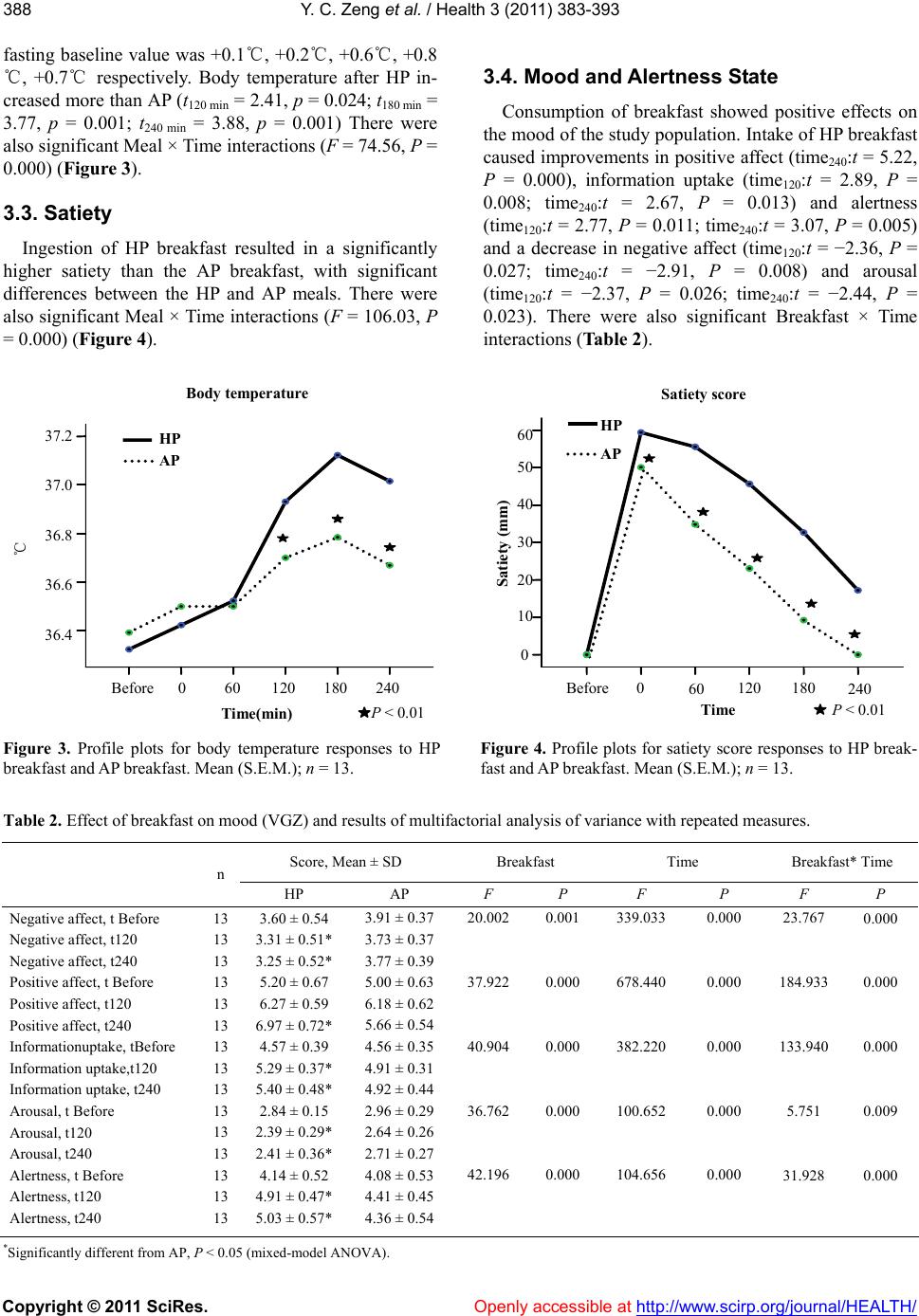 Y. C. Zeng et al. / Health 3 (20 11) 383-393 Copyright © 2011 SciRes. Openly accessible at http://www.scirp.org/journal/HEALTH/ 388 fasting baseline value was +0.1℃, +0.2℃, +0.6℃, +0.8 ℃, +0.7℃ respectively. Body temperature after HP in- creased more than AP (t120 min = 2.41, p = 0.024; t180 min = 3.77, p = 0.001; t240 min = 3.88, p = 0.001) There were also significant Meal × Time interactions (F = 74.56, P = 0.000) (Figure 3). 3.3. Satiety Ingestion of HP breakfast resulted in a significantly higher satiety than the AP breakfast, with significant differences between the HP and AP meals. There were also significant Meal × Time interactions (F = 106.03, P = 0.000) (Figure 4). 3.4. Mood and Alertness State Consumption of breakfast showed positive effects on the mood of the study population. Intake of HP breakfast caused improvements in positive affect (time240:t = 5.22, P = 0.000), information uptake (time120:t = 2.89, P = 0.008; time240:t = 2.67, P = 0.013) and alertness (time120:t = 2.77, P = 0.011; time240 :t = 3.07, P = 0.005) and a decrease in negative affect (time120:t = −2.36, P = 0.027; time240:t = −2.91, P = 0.008) and arousal (time120:t = −2.37, P = 0.026; time240:t = −2.44, P = 0.023). There were also significant Breakfast × Time interactions (Table 2). 240180 120 60 Before Time(min) 37.2 37.0 36.8 36.6 36.4 ℃ Body temper ature HP AP < 0.01 Figure 3. Profile plots for body temperature responses to HP breakfast and AP breakfast. Mean (S.E.M.); n = 13. 240 180 120 60 0 < 0.01 Time 60 50 40 30 20 10 0 Satiet mm AP HP Satiety score Before Figure 4. Profile plots for satiety score responses to HP break- fast and AP breakfast. Mean (S.E.M.); n = 13. Table 2. Effect of breakfast on mood (VGZ) and results of multifactorial analysis of variance with repeated measures. Score, Mean ± SD Breakfast Time Breakfast* Time n HP AP F P F P F P Negative affect, t Before Negative affect, t120 Negative affect, t240 Positive affect, t Before Positive affect, t120 Positive affect, t240 Informationuptake, tBefore Information uptake,t120 Information uptake, t240 Arousal, t Before Arousal, t120 Arousal, t240 Alertness, t Before Alertness, t120 Alertness, t240 13 13 13 13 13 13 13 13 13 13 13 13 13 13 13 3.60 ± 0.54 3.31 ± 0.51* 3.25 ± 0.52* 5.20 ± 0.67 6.27 ± 0.59 6.97 ± 0.72* 4.57 ± 0.39 5.29 ± 0.37* 5.40 ± 0.48* 2.84 ± 0.15 2.39 ± 0.29* 2.41 ± 0.36* 4.14 ± 0.52 4.91 ± 0.47* 5.03 ± 0.57* 3.91 ± 0.37 3.73 ± 0.37 3.77 ± 0.39 5.00 ± 0.63 6.18 ± 0.62 5.66 ± 0.54 4.56 ± 0.35 4.91 ± 0.31 4.92 ± 0.44 2.96 ± 0.29 2.64 ± 0.26 2.71 ± 0.27 4.08 ± 0.53 4.41 ± 0.45 4.36 ± 0.54 20.002 37.922 40.904 36.762 42.196 0.001 0.000 0.000 0.000 0.000 339.033 678.440 382.220 100.652 104.656 0.000 0.000 0.000 0.000 0.000 23.767 184.933 133.940 5.751 31.928 0.000 0.000 0.000 0.009 0.000 *Significantly different from AP, P < 0.05 (mixed-model ANOVA).  Y. C. Zeng et al. / Health 3 (20 11) 383-393 Copyright © 2011 SciRes. Openly accessible at http://www.scirp.org/journal/HEALTH/ 389389 3.5. Continuous Performance Task HP breakfast was associated with a significant raise the hit rate at both ISIs. Post hoc t-tests confirmed sig- nificantly higher hit rates during HP breakfast than dur- ing the baseline and AP session. HP breakfast was asso- ciated with a decline of false alarms, which was most pronounced for false alarms to AY and BX sequences at long ISIs. HP breakfast also declined for false alarms to AY and BX sequences at short ISIs. In addition, there were not false alarms to BY at any moments in two ses- sions (Figure 5). 4. CORRELATIONS 4.1. Blood Glucose and Target Variables Three kinds of positive emotion were correlated with concentrations of blood glucose at 240 min (r240min = 0.65, p = 0.000). Two kinds of negative emotion were negative correlation with concentrations of blood glu- cose (r240min = −0.53, p = 0.006). Total continuous per- formance task scores at 240 min were correlated with concentrations of blood glucose (r240 min = 0.87, p = 0.000). No significant associations were observed be- tween total CPT scores and concentrations of blood glu- cose at 0 min, 120 min. 4.2. Body Temperature and Target Variables Three kinds of positive emotion at three moments were correlated with body temperature significantly (rbe- fore = 0.86, p = 0.000; r120min = 0.95, p = 0.000; r240min = 0.95, p = 0.000). Two kinds of negative emotion at three moments were negative correlation with body tempera- ture (rbefore = −0.78, p = 0.000; r120 min = −0.95, p = 0.000; r240 min = −0.91, p = 0.000). Furthermore, total continu- ous performance task scores before breakfast, at 120 min and 240 min after breakfast all were correlated with body temperature (rbefore = 0.59, p = 0.002; r120 min = 0.73, p = 0.000; r240 min = 0.85, p = 0.000). 5. DISCUSSION The present study showed that differences within pro- tein to energy ratios in an isoenergetic breakfast can re- sult in a different effect on perception of satiety, mood state and CPT scores in healthy male subjects. Our data reveal significant HP breakfast meal effects as well as Meal × Time interactions for CPT scores after the inges- tion of meals with different protein to energy ratios in the morning. Overall CPT performance was better after HP breakfast meal than after AP breakfast. In addition, changes in CPT performance and mood were related to postprandial changes in glucose concentrations and body temperature. Two test meals were moderately liked by the subjects. As energy content, volume, acceptance, and sensory properties of our test meals were matched, the observed effects on metabolic, mood, and CPT scores can be attributed to the ratio of protein to energy in- gested. Interpreting cognitive effects after macronutrient ingestion, the energy content, sex, age and the constitu- tion of the subjects as well as the time have to be con- sidered [27]. Our subjects were healthy young male stu- dents, and the test meals matched their habitual breakfast size. The subjects’ glycogen stores were approximately not completely depleted because of the carbohy- drate-rich 240 min 120 min Before 1.0 0.8 0.6 0.4 0.2 0.0 1.0 0.8 0.6 0.4 0.2 0.0 Short ISI Hit Rate a a Long ISI Hit Rate Hit AP HP 0.08 0.07 0.06 0.05 0.04 0.03 0.02 0.01 0.0 Short ISI FA Rate a a a 0.1 0.08 0.06 0.04 0.02 0.0 Short ISI FA Rate a e c a AY 0.08 0.07 0.06 0.05 0.04 0.03 0.02 0.01 0.0 Long ISI FA Rate e c BX 0.1 0.08 0.06 0.04 0.02 0.0 Long ISI FA Rate 240 min120 min Before 240 min120 min Before Figure 5. Effects of HP breakfast and AP breakfast on CPT performance. Mean (S.E.M.); n = 13. Bars without a common superscript differ significantly (P < 0.01). 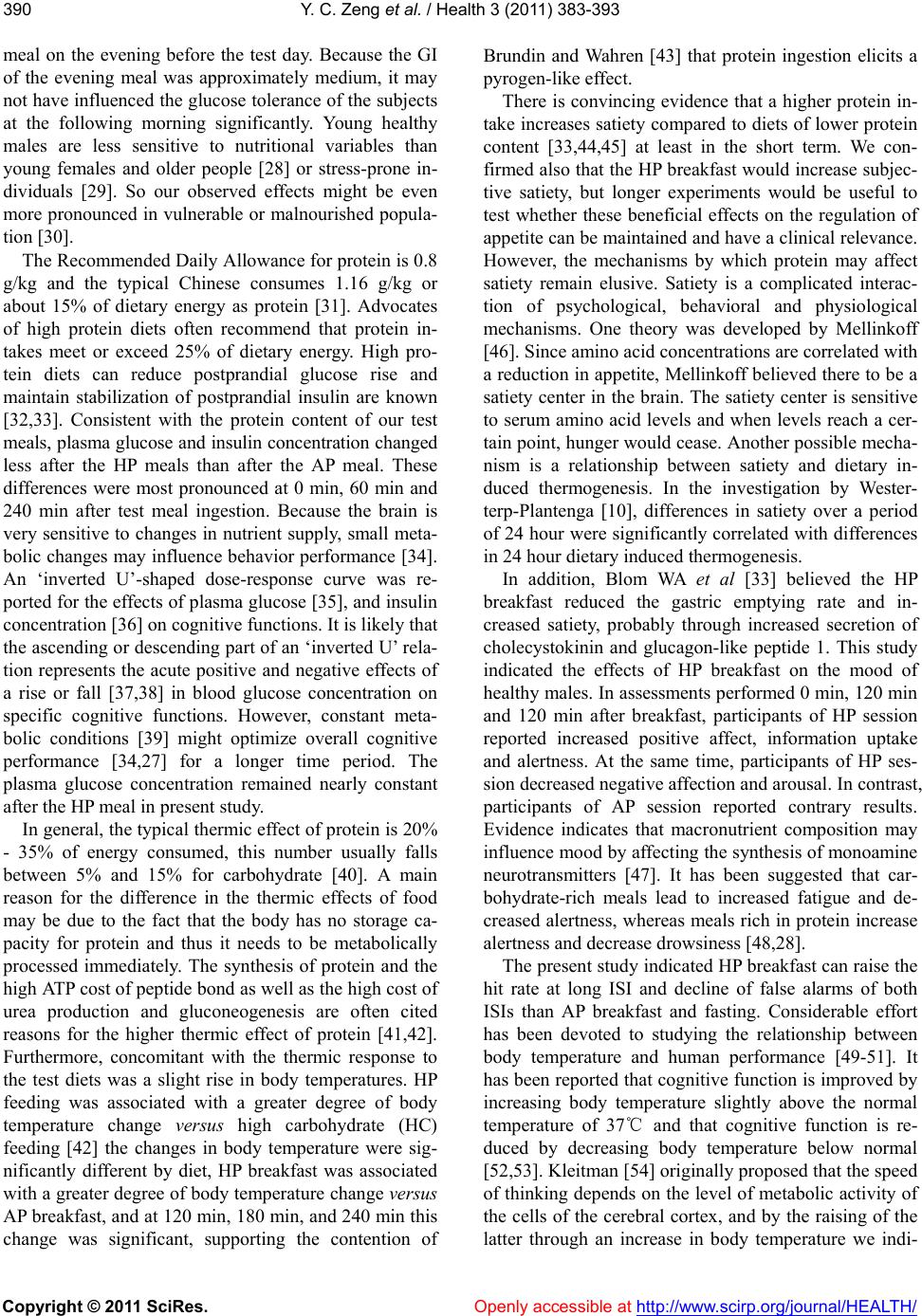 Y. C. Zeng et al. / Health 3 (20 11) 383-393 Copyright © 2011 SciRes. Openly accessible at http://www.scirp.org/journal/HEALTH/ 390 meal on the evening before the test day. Because the GI of the evening meal was approximately medium, it may not have influenced the glucose tolerance of the subjects at the following morning significantly. Young healthy males are less sensitive to nutritional variables than young females and older people [28] or stress-prone in- dividuals [29]. So our observed effects might be even more pronounced in vulnerable or malnourished popula- tion [30]. The Recommended Daily Allowance for protein is 0.8 g/kg and the typical Chinese consumes 1.16 g/kg or about 15% of dietary energy as protein [31]. Advocates of high protein diets often recommend that protein in- takes meet or exceed 25% of dietary energy. High pro- tein diets can reduce postprandial glucose rise and maintain stabilization of postprandial insulin are known [32,33]. Consistent with the protein content of our test meals, plasma glucose and insulin concentration changed less after the HP meals than after the AP meal. These differences were most pronounced at 0 min, 60 min and 240 min after test meal ingestion. Because the brain is very sensitive to changes in nutrient supply, small meta- bolic changes may influence behavior performance [34]. An ‘inverted U’-shaped dose-response curve was re- ported for the effects of plasma glucose [35], and insulin concentration [36] on cognitive functions. It is likely that the ascending or descending part of an ‘inverted U’ rela- tion represents the acute positive and negative effects of a rise or fall [37,38] in blood glucose concentration on specific cognitive functions. However, constant meta- bolic conditions [39] might optimize overall cognitive performance [34,27] for a longer time period. The plasma glucose concentration remained nearly constant after the HP meal in present study. In general, the typical thermic effect of protein is 20% - 35% of energy consumed, this number usually falls between 5% and 15% for carbohydrate [40]. A main reason for the difference in the thermic effects of food may be due to the fact that the body has no storage ca- pacity for protein and thus it needs to be metabolically processed immediately. The synthesis of protein and the high ATP cost of peptide bond as well as the high cost of urea production and gluconeogenesis are often cited reasons for the higher thermic effect of protein [41,42]. Furthermore, concomitant with the thermic response to the test diets was a slight rise in body temperatures. HP feeding was associated with a greater degree of body temperature change versus high carbohydrate (HC) feeding [42] the changes in body temperature were sig- nificantly different by diet, HP breakfast was associated with a greater degree of body temperature change versus AP breakfast, and at 120 min, 180 min, and 240 min this change was significant, supporting the contention of Brundin and Wahren [43] that protein ingestion elicits a pyrogen-like effect. There is convincing evidence that a higher protein in- take increases satiety compared to diets of lower protein content [33,44,45] at least in the short term. We con- firmed also that the HP breakfast would increase subjec- tive satiety, but longer experiments would be useful to test whether these beneficial effects on the regulation of appetite can be maintained and have a clinical relevance. However, the mechanisms by which protein may affect satiety remain elusive. Satiety is a complicated interac- tion of psychological, behavioral and physiological mechanisms. One theory was developed by Mellinkoff [46]. Since amino acid concentrations are correlated with a reduction in appetite, Mellinkoff believed there to be a satiety center in the brain. The satiety center is sensitive to serum amino acid levels and when levels reach a cer- tain point, hunger would cease. Another possible mecha- nism is a relationship between satiety and dietary in- duced thermogenesis. In the investigation by Wester- terp-Plantenga [10], differences in satiety over a period of 24 hour were significantly correlated with differences in 24 hour dietary induced thermogenesis. In addition, Blom WA et al [33] believed the HP breakfast reduced the gastric emptying rate and in- creased satiety, probably through increased secretion of cholecystokinin and glucagon-like peptide 1. This study indicated the effects of HP breakfast on the mood of healthy males. In assessments performed 0 min, 120 min and 120 min after breakfast, participants of HP session reported increased positive affect, information uptake and alertness. At the same time, participants of HP ses- sion decreased negative affection and arousal. In contrast, participants of AP session reported contrary results. Evidence indicates that macronutrient composition may influence mood by affecting the synthesis of monoamine neurotransmitters [47]. It has been suggested that car- bohydrate-rich meals lead to increased fatigue and de- creased alertness, whereas meals rich in protein increase alertness and decrease drowsiness [48,28]. The present study indicated HP breakfast can raise the hit rate at long ISI and decline of false alarms of both ISIs than AP breakfast and fasting. Considerable effort has been devoted to studying the relationship between body temperature and human performance [49-51]. It has been reported that cognitive function is improved by increasing body temperature slightly above the normal temperature of 37℃ and that cognitive function is re- duced by decreasing body temperature below normal [52,53]. Kleitman [54] originally proposed that the speed of thinking depends on the level of metabolic activity of the cells of the cerebral cortex, and by the raising of the latter through an increase in body temperature we indi-  Y. C. Zeng et al. / Health 3 (20 11) 383-393 Copyright © 2011 SciRes. Openly accessible at http://www.scirp.org/journal/HEALTH/ 391391 rectly speed up the thought process. Kleitman’s hy- pothesis is supported by results from studies [55,56] that higher brain temperatures resulted in faster transmission, whereas lower brain temperature resulted in slower transmission. Moreover, when body temperature was high, alertness was rated higher. We also hypothesized that protein exerts its mood ef- fects partly through the elevation of postprandial body temperature and glucose concentrations. By bivariate correlation analyses, we found the positive association between body temperature and subjective positive mood, CPT scores at all moments(0 min, 120 min and 240 min); whereas negative association between body temperature and subjective negative mood. However, the above- mentioned association between glucose concentrations and subjective mood, CPT scores only at 240 min after test breakfast. 6. CONCLUSIONS To conclude, HP breakfast can effectively stabilize postprandial serum glucose concentrations and elevate postprandial temperature of healthy male undergraduate students. Our present findings demonstrate the relation- ship between HP breakfast and mood, alertness and at- tention. This study indicated that HP breakfast may en- hance human performance probably by increasing the thermic effect of a food and elevating body temperature. This randomized trial demonstrated positive short-term effects of HP breakfast on mood and CPT performance in undergraduate students. The observed differences ac- cording to gender and potential mediating effects be- tween mood and performance deserve further investiga- tion. 7. ACKNOWLEDGEMENTS We thank Li-Bo Zhou for providing us with the statistical expertise. We thank Yan-Lin Zhou, Wen-Feng Zhao and Yun-Zhang for their technical assistance. We are also grateful to the research volunteers and a number of assistants of our hospital for their experimental assistance during the study. Competing interests: The authors declare that they have no com- peting interests. Authors’ contributions: YZ designed and carried out the experi- ment of this manuscript and drafted the manuscript and approved the final manuscript; SL and GX participated in the design of the study and revised the manuscript. HS and JW participated the experiment. All authors read and approved the final manuscript. All authors lacked any conflict of interest. REFERENCES [1] Wurtman, R.J. and Wurtman, J.J. (1989) Carbohydrates and depression. Scientific American, 260, 68-75. doi:10.1038/scientificamerican0189-68 [2] Simopoulos, A.P. (1999) Essential fatty acids in health and chronic disease. The American Journal of Clinical Nutrition, 70, 560S-569S. [3] Arnold, S.M., Lynn, T.V., Verbrugge, L.A. and Middaugh, J.P. (2005) Human biomonitoring to optimize fish con- sumption advice: Reducing uncertainty when evaluating benefits and risks. American Journal of Public Health, 95, 393-397. doi:10.2105/AJPH.2004.042879 [4] Rogers, P.J., Appleton, K.M., Kessler, D., Peters, T.J., Gunnell, D., Hayward, R.C., Heatherley, S.V., Christian, L.M., McNaughton, S.A. and Ness, A.R. (2008) No ef- fect of n-3 long-chain polyunsaturated fatty acid (EPA and DHA) supplementation on depressed mood and cog- nitive function: a randomized controlled trial. British Journal of Nutrition, 99, 421-431. doi:10.1017/S0007114507801097 [5] Tappy, L. (1996) Thermic effect of food and sympathetic nervous system activity in humans. Reproduction Nutri- tion Development, 36, 391-397. doi:10.1051/rnd:19960405 [6] Poppitt, S.D., McCormack, D. and Buffenstein, R. (1998) Short-term effects of macronutrient preloads on appetite and energy intake in lean women. Physiology & Behav- ior, 64, 279-285. doi:10.1016/S0031-9384(98)00061-4 [7] Eisenstein, J., Roberts, S.B., Dallal, G. and Saltzman, E. (2002) High-protein weightloss diets: are they safe and do they work? A review of the experimental and epide- miologic data. Nutrition Reviews, 60, 189-200. doi:10.1301/00296640260184264 [8] Yancy, W.S., Olsen, M.K., Guyton, J.R., Bakst, R.P. and Westman, E.C. (2004) A low-carbohydrate, ketogenic diet versus a low-fat diet to treat obesity and hyperlipi- demia: a randomized, controlled trial. Annals of Internal Medicine, 140, 769-777. [9] Astrup, A. (2005) The satiating power of protein—a key to obesity prevention? The American Journal of Clinical Nutrition, 82, 1-2. [10] Westerterp-Plantenga, M.S., Rolland, V., Wilson, S.A. and Westerterp, K.R. (1999) Satiety related to 24 h diet- induced thermogenesis during high protein/carbohydrate vs high fat diets measured in a respiration chamber. European Journal of Clinical Nutrition, 53, 495-502. doi:10.1038/sj.ejcn.1600782 [11] Westman, E.C., Yancy, W.S., Edman, J.S., Tomlin, K.F. and Perkins, C.E. (2002) Effect of 6-month adherence to a very low carbohydrate diet program,” American Jour- nal of Medicine, 114, 30-36. doi:10.1016/S0002-9343(02)01129-4 [12] Raben, A., Agerholm-Larsen, L., Flint, A., Holst, J.J. and Astrup, A. (2003) Meals with similar energy densities but rich in protein, fat, carbohydrate, or alcohol have differ- ent effects on energy expenditure and substrate metabo- lism but not on appetite and energy intake. The American Journal of Clinical Nutrition, 77, 91-100. [13] Parker, B., Noakes, M., Luscombe, N. and Clifton, P. (2002) Effect of a high-protein, high-monounsaturated fat weight loss diet on glycemic control and lipid levels in type 2 diabetes. Diabetes Care, 25, 425-430. 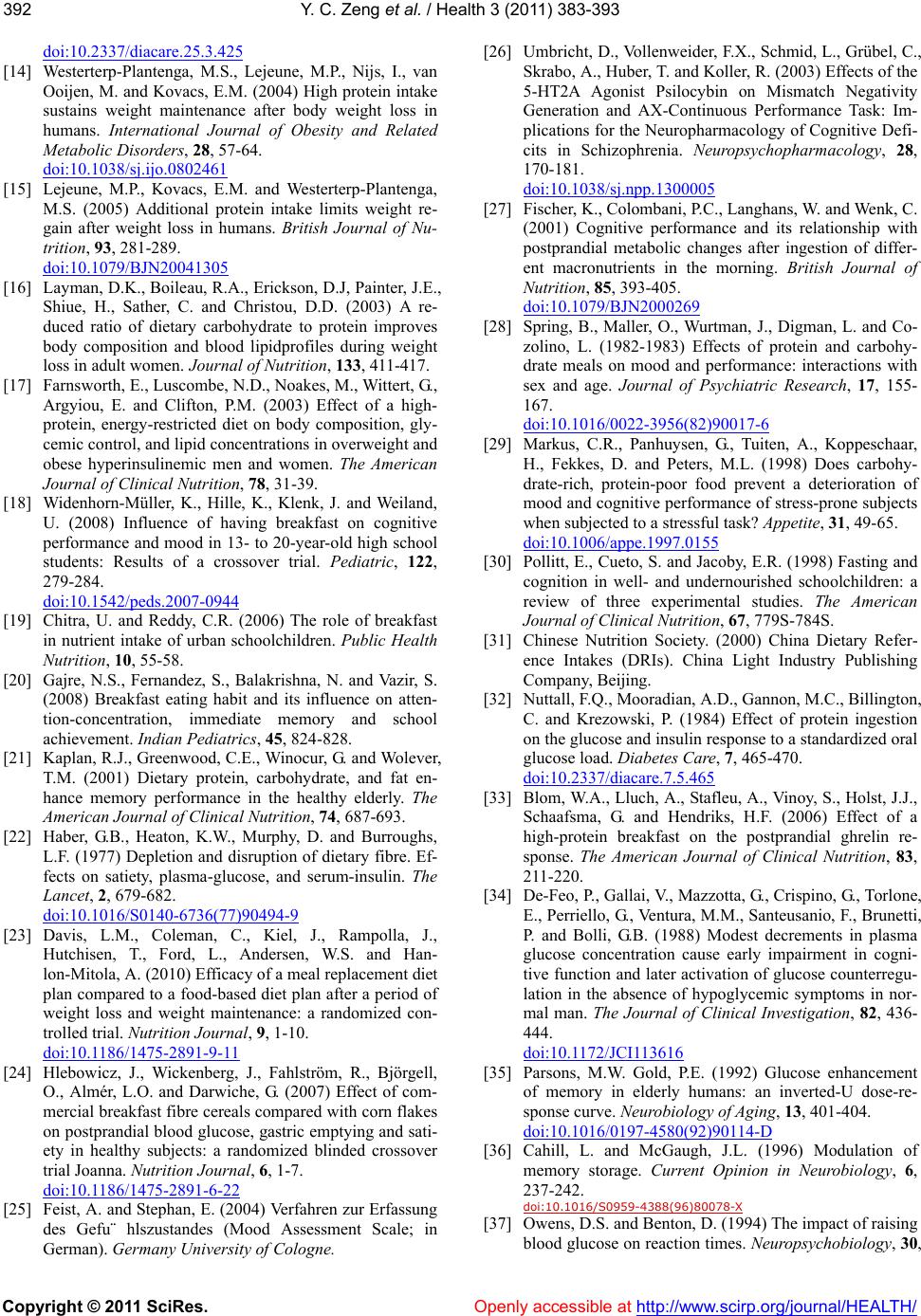 Y. C. Zeng et al. / Health 3 (20 11) 383-393 Copyright © 2011 SciRes. Openly accessible at http://www.scirp.org/journal/HEALTH/ 392 doi:10.2337/diacare.25.3.425 [14] Westerterp-Plantenga, M.S., Lejeune, M.P., Nijs, I., van Ooijen, M. and Kovacs, E.M. (2004) High protein intake sustains weight maintenance after body weight loss in humans. International Journal of Obesity and Related Metabolic Disorders, 28, 57-64. doi:10.1038/sj.ijo.0802461 [15] Lejeune, M.P., Kovacs, E.M. and Westerterp-Plantenga, M.S. (2005) Additional protein intake limits weight re- gain after weight loss in humans. British Journal of Nu- trition, 93, 281-289. doi:10.1079/BJN20041305 [16] Layman, D.K., Boileau, R.A., Erickson, D.J, Painter, J.E., Shiue, H., Sather, C. and Christou, D.D. (2003) A re- duced ratio of dietary carbohydrate to protein improves body composition and blood lipidprofiles during weight loss in adult women. Journal of Nutrition, 133, 411-417. [17] Farnsworth, E., Luscombe, N.D., Noakes, M., Wittert, G., Argyiou, E. and Clifton, P.M. (2003) Effect of a high- protein, energy-restricted diet on body composition, gly- cemic control, and lipid concentrations in overweight and obese hyperinsulinemic men and women. The American Journal of Clinical Nutrition, 78, 31-39. [18] Widenhorn-Müller, K., Hille, K., Klenk, J. and Weiland, U. (2008) Influence of having breakfast on cognitive performance and mood in 13- to 20-year-old high school students: Results of a crossover trial. Pediatric, 122, 279-284. doi:10.1542/peds.2007-0944 [19] Chitra, U. and Reddy, C.R. (2006) The role of breakfast in nutrient intake of urban schoolchildren. Public Health Nutrition, 10, 55-58. [20] Gajre, N.S., Fernandez, S., Balakrishna, N. and Vazir, S. (2008) Breakfast eating habit and its influence on atten- tion-concentration, immediate memory and school achievement. Indian Pediatrics, 45, 824-828. [21] Kaplan, R.J., Greenwood, C.E., Winocur, G. and Wolever, T.M. (2001) Dietary protein, carbohydrate, and fat en- hance memory performance in the healthy elderly. The American Journal of Clinical Nutrition, 74, 687-693. [22] Haber, G.B., Heaton, K.W., Murphy, D. and Burroughs, L.F. (1977) Depletion and disruption of dietary fibre. Ef- fects on satiety, plasma-glucose, and serum-insulin. The Lancet, 2, 679-682. doi:10.1016/S0140-6736(77)90494-9 [23] Davis, L.M., Coleman, C., Kiel, J., Rampolla, J., Hutchisen, T., Ford, L., Andersen, W.S. and Han- lon-Mitola, A. (2010) Efficacy of a meal replacement diet plan compared to a food-based diet plan after a period of weight loss and weight maintenance: a randomized con- trolled trial. Nutrition Journal, 9, 1-10. doi:10.1186/1475-2891-9-11 [24] Hlebowicz, J., Wickenberg, J., Fahlström, R., Björgell, O., Almér, L.O. and Darwiche, G. (2007) Effect of com- mercial breakfast fibre cereals compared with corn flakes on postprandial blood glucose, gastric emptying and sati- ety in healthy subjects: a randomized blinded crossover trial Joanna. Nu trition Journal, 6, 1-7. doi:10.1186/1475-2891-6-22 [25] Feist, A. and Stephan, E. (2004) Verfahren zur Erfassung des Gefu¨ hlszustandes (Mood Assessment Scale; in German). Germany University of Cologne. [26] Umbricht, D., Vollenweider, F.X., Schmid, L., Grübel, C., Skrabo, A., Huber, T. and Koller, R. (2003) Effects of the 5-HT2A Agonist Psilocybin on Mismatch Negativity Generation and AX-Continuous Performance Task: Im- plications for the Neuropharmacology of Cognitive Defi- cits in Schizophrenia. Neuropsychopharmacology, 28, 170-181. doi:10.1038/sj.npp.1300005 [27] Fischer, K., Colombani, P.C., Langhans, W. and Wenk, C. (2001) Cognitive performance and its relationship with postprandial metabolic changes after ingestion of differ- ent macronutrients in the morning. British Journal of Nutrition, 85, 393-405. doi:10.1079/BJN2000269 [28] Spring, B., Maller, O., Wurtman, J., Digman, L. and Co- zolino, L. (1982-1983) Effects of protein and carbohy- drate meals on mood and performance: interactions with sex and age. Journal of Psychiatric Research, 17, 155- 167. doi:10.1016/0022-3956(82)90017-6 [29] Markus, C.R., Panhuysen, G., Tuiten, A., Koppeschaar, H., Fekkes, D. and Peters, M.L. (1998) Does carbohy- drate-rich, protein-poor food prevent a deterioration of mood and cognitive performance of stress-prone subjects when subjected to a stressful task? Appetite, 31, 49-65. doi:10.1006/appe.1997.0155 [30] Pollitt, E., Cueto, S. and Jacoby, E.R. (1998) Fasting and cognition in well- and undernourished schoolchildren: a review of three experimental studies. The American Journal of Clinical Nutrition, 67, 779S-784S. [31] Chinese Nutrition Society. (2000) China Dietary Refer- ence Intakes (DRIs). China Light Industry Publishing Company, Beijing. [32] Nuttall, F.Q., Mooradian, A.D., Gannon, M.C., Billington, C. and Krezowski, P. (1984) Effect of protein ingestion on the glucose and insulin response to a standardized oral glucose load. Diabetes Care, 7, 465-470. doi:10.2337/diacare.7.5.465 [33] Blom, W.A., Lluch, A., Stafleu, A., Vinoy, S., Holst, J.J., Schaafsma, G. and Hendriks, H.F. (2006) Effect of a high-protein breakfast on the postprandial ghrelin re- sponse. The American Journal of Clinical Nutrition, 83, 211-220. [34] De-Feo, P., Gallai, V., Mazzotta, G., Crispino, G., Torlone, E., Perriello, G., Ventura, M.M., Santeusanio, F., Brunetti, P. and Bolli, G.B. (1988) Modest decrements in plasma glucose concentration cause early impairment in cogni- tive function and later activation of glucose counterregu- lation in the absence of hypoglycemic symptoms in nor- mal man. The Journal of Clinical Investigation, 82, 436- 444. doi:10.1172/JCI113616 [35] Parsons, M.W. Gold, P.E. (1992) Glucose enhancement of memory in elderly humans: an inverted-U dose-re- sponse curve. Neurobiology of Aging, 13, 401-404. doi:10.1016/0197-4580(92)90114-D [36] Cahill, L. and McGaugh, J.L. (1996) Modulation of memory storage. Current Opinion in Neurobiology, 6, 237-242. doi:10.1016/S0959-4388(96)80078-X [37] Owens, D.S. and Benton, D. (1994) The impact of raising blood glucose on reaction times. Neuropsychobiology, 30, 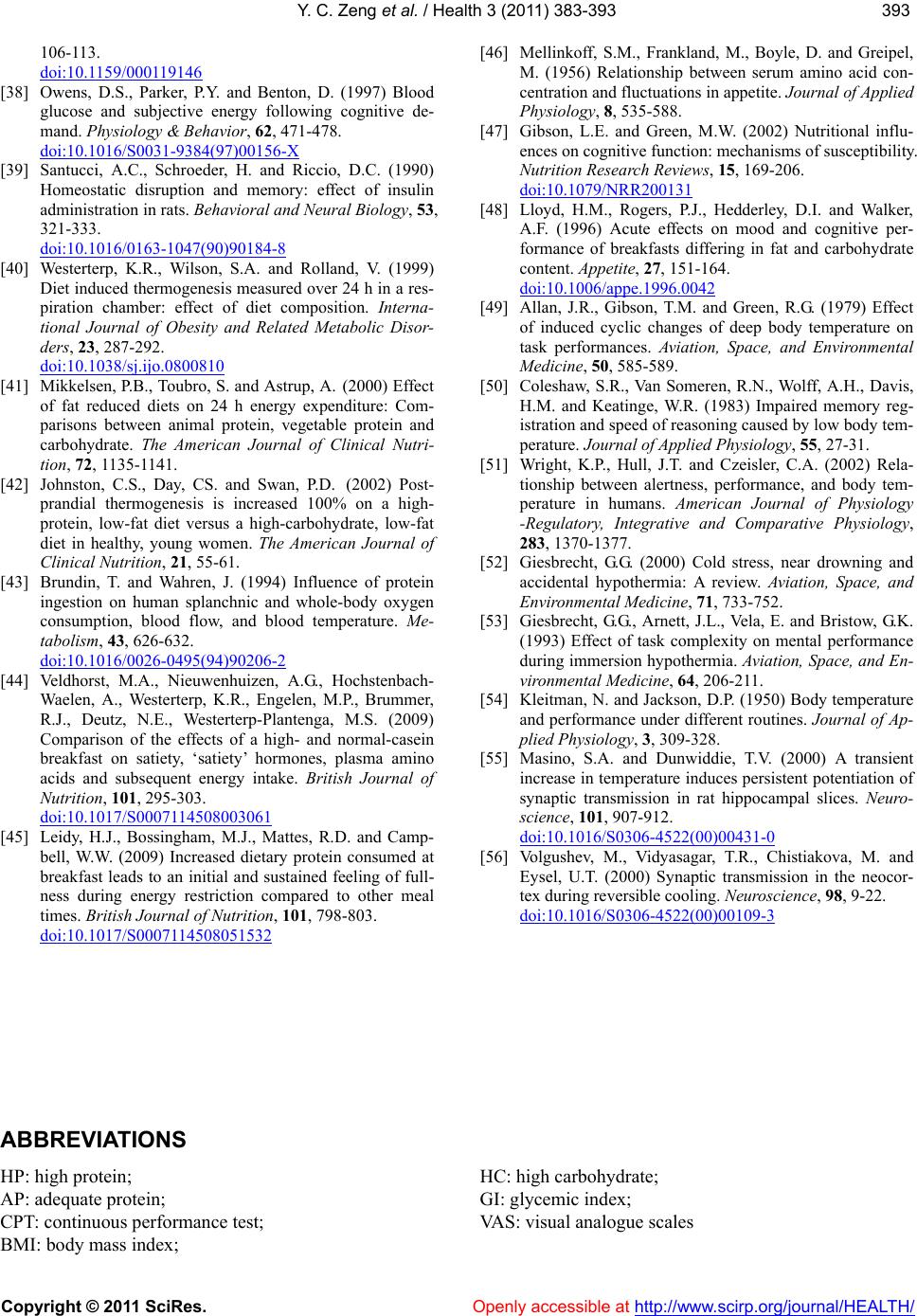 Y. C. Zeng et al. / Health 3 (20 11) 383-393 Copyright © 2011 SciRes. http://www.scirp.org/journal/HEALTH/Openly accessible at 393393 106-113. doi:10.1159/000119146 [38] Owens, D.S., Parker, P.Y. and Benton, D. (1997) Blood glucose and subjective energy following cognitive de- mand. Physiology & Behavior, 62, 471-478. doi:10.1016/S0031-9384(97)00156-X [39] Santucci, A.C., Schroeder, H. and Riccio, D.C. (1990) Homeostatic disruption and memory: effect of insulin administration in rats. Behavioral and Neural Biology, 53, 321-333. doi:10.1016/0163-1047(90)90184-8 [40] Westerterp, K.R., Wilson, S.A. and Rolland, V. (1999) Diet induced thermogenesis measured over 24 h in a res- piration chamber: effect of diet composition. Interna- tional Journal of Obesity and Related Metabolic Disor- ders, 23, 287-292. doi:10.1038/sj.ijo.0800810 [41] Mikkelsen, P.B., Toubro, S. and Astrup, A. (2000) Effect of fat reduced diets on 24 h energy expenditure: Com- parisons between animal protein, vegetable protein and carbohydrate. The American Journal of Clinical Nutri- tion, 72, 1135-1141. [42] Johnston, C.S., Day, CS. and Swan, P.D. (2002) Post- prandial thermogenesis is increased 100% on a high- protein, low-fat diet versus a high-carbohydrate, low-fat diet in healthy, young women. The American Journal of Clinical Nutrition, 21, 55-61. [43] Brundin, T. and Wahren, J. (1994) Influence of protein ingestion on human splanchnic and whole-body oxygen consumption, blood flow, and blood temperature. Me- tabolism, 43, 626-632. doi:10.1016/0026-0495(94)90206-2 [44] Veldhorst, M.A., Nieuwenhuizen, A.G., Hochstenbach- Waelen, A., Westerterp, K.R., Engelen, M.P., Brummer, R.J., Deutz, N.E., Westerterp-Plantenga, M.S. (2009) Comparison of the effects of a high- and normal-casein breakfast on satiety, ‘satiety’ hormones, plasma amino acids and subsequent energy intake. British Journal of Nutrition, 101, 295-303. doi:10.1017/S0007114508003061 [45] Leidy, H.J., Bossingham, M.J., Mattes, R.D. and Camp- bell, W.W. (2009) Increased dietary protein consumed at breakfast leads to an initial and sustained feeling of full- ness during energy restriction compared to other meal times. British Journal of Nutrition, 101, 798-803. doi:10.1017/S0007114508051532 [46] Mellinkoff, S.M., Frankland, M., Boyle, D. and Greipel, M. (1956) Relationship between serum amino acid con- centration and fluctuations in appetite. Journal of Applied Physiology, 8, 535-588. [47] Gibson, L.E. and Green, M.W. (2002) Nutritional influ- ences on cognitive function: mechanisms of susceptibility. Nutrition Research Reviews, 15, 169-206. doi:10.1079/NRR200131 [48] Lloyd, H.M., Rogers, P.J., Hedderley, D.I. and Walker, A.F. (1996) Acute effects on mood and cognitive per- formance of breakfasts differing in fat and carbohydrate content. Appetite, 27, 151-164. doi:10.1006/appe.1996.0042 [49] Allan, J.R., Gibson, T.M. and Green, R.G. (1979) Effect of induced cyclic changes of deep body temperature on task performances. Aviation, Space, and Environmental Medicine, 50, 585-589. [50] Coleshaw, S.R., Van Someren, R.N., Wolff, A.H., Davis, H.M. and Keatinge, W.R. (1983) Impaired memory reg- istration and speed of reasoning caused by low body tem- perature. Journal of Applied Physiology, 55, 27-31. [51] Wright, K.P., Hull, J.T. and Czeisler, C.A. (2002) Rela- tionship between alertness, performance, and body tem- perature in humans. American Journal of Physiology -Regulatory, Integrative and Comparative Physiology, 283, 1370-1377. [52] Giesbrecht, G.G. (2000) Cold stress, near drowning and accidental hypothermia: A review. Aviation, Space, and Environmental Medicin e, 71, 733-752. [53] Giesbrecht, G.G., Arnett, J.L., Vela, E. and Bristow, G.K. (1993) Effect of task complexity on mental performance during immersion hypothermia. Aviation, Space, and En- vironmental Medicine, 64, 206-211. [54] Kleitman, N. and Jackson, D.P. (1950) Body temperature and performance under different routines. Journal of Ap- plied Physiology, 3, 309-328. [55] Masino, S.A. and Dunwiddie, T.V. (2000) A transient increase in temperature induces persistent potentiation of synaptic transmission in rat hippocampal slices. Neuro- science, 101, 907-912. doi:10.1016/S0306-4522(00)00431-0 [56] Volgushev, M., Vidyasagar, T.R., Chistiakova, M. and Eysel, U.T. (2000) Synaptic transmission in the neocor- tex during reversible cooling. Neuroscience, 98, 9-22. doi:10.1016/S0306-4522(00)00109-3 ABBREVIATIONS HP: high protein; AP: adequate protein; CPT: continuous performance test; B MI: body mass index; HC: high carbohydrate; GI: glycemic index; VAS: visual analogue scales
|